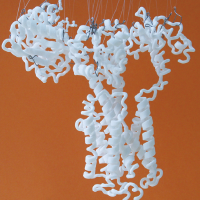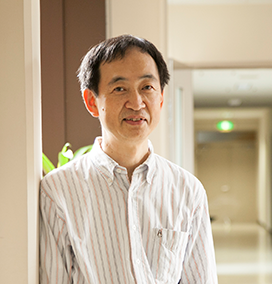Theme
The Imperial Prize and the Japan Academy Prize in 2018 were awarded to Prof. Toyoshima for his “Elucidation of the Molecular Mechanism of the ATP-driven Ion-transport across the Membranes”
About Research
Understanding membrane transporters through their atomic structures
Since proteins have to change their three-dimensional structures to achieve their functions, it is impossible to understand how they work without knowing their 3D structures. We aim at understanding the functions of important proteins based on the atomic structures using X-ray crystallography as the principal tool. We focus on the structural basis of active ion transport and have already succeeded in determining the atomic structures for 10 different states that nearly cover the entire reaction cycle of the calcium pump (1-4). As a result, we now roughly understand how ion pumps work and can answer fundamental questions, e.g. what ATP and phosphorylation do. Crystal structures represent, however, only a few points in the reaction cycle and protons, which play important roles in structural changes and functions, are invisible to X-ray. Therefore, theoretical calculations are also important in our study. We have also established an expression system using mammalian cell culture and succeeded in crystal structure analysis of a mutant (8, 9). Such technology is unique and will become more and more important. Another principal target of our study, in collaboration with a Danish group, is the sodium pump (6, 7, 10), which is expressed in all animal cells and deeply implicated in many diseases.
These results have been recognized world-wide and Prof. Toyoshima was elected to prestigious International Member of the National Academy of Science, U.S.A. and a Hitchcock Professor at UC Barkeley. His lectures and interview can be seen on YouTube. He was also awarded a Medal with Purple Ribbon in 2015, Gregori Aminoff Prize in 2016 and the Imperial and Japan Academy Prizes in 2018.
Publication
- C. Toyoshima, M. Nakasako, H. Nomura and H. Ogawa: Crystal structure of the calcium pump of sarcoplasmic reticulum at 2.6 Å resolution. Nature 405, 647-655 (2000)
- C. Toyoshima and T. Mizutani: Crystal structure of the calcium pump with a bound ATP analogue. Nature 430, 529-535 (2004)
- C. Toyoshima, H. Nomura and T. Tsuda: Lumenal gating mechanism revealed in calcium pump crystal structures with phosphate analogues. Nature 432, 361-368 (2004)
- C. Toyoshima, S. Iwasawa, H. Ogawa, A. Hirata, J. Tsueda and G. Inesi: Crystal structures of the calcium pump and sarcolipin in the·Mg2+-bound E1 state. Nature 495, 260-264 (2013)
- Y. Norimatsu, K. Hasegawa, N. Shimizu and C. Toyoshima: Protein–phospholipid interplay revealed with crystals of a calcium pump. Nature, 545, 193-198 (2017)
- T. Shinoda, H. Ogawa, F. Cornelius and C. Toyoshima: Crystal structure of the sodium-potassium pump at 2.4 Å resolution. Nature 459, 446-450 (2009)
- R. Kanai, H. Ogawa, B. Vilsen, F. Cornelius and C. Toyoshima: Crystal structure of a Na+-bound Na+,K+-ATPase preceding the E1P state. Nature 502, 201-206 (2013)
- N. Tsunekawa, H. Ogawa, J. Tsueda and C. Toyoshima: Mechanism of the E2 to E1 transition in Ca2+-pump revealed by crystal structures of gating residue mutants. Proc.Natl.Acad.Sci. USA. 115, 12722-12727 (2018)
- Y. Kabashima, H. Ogawa, R. Nakajima and C. Toyoshima: What ATP binding does to the Ca2+ pump and how nonproductive phosphoryl transfer is prevented in the absence of Ca2+. Proc.Natl.Acad.Sci. USA. 117, 18448-118458 (2020)
- R. Kanai, F. Cornelius, B. Vilsen and C. Toyoshima: Cryoelectron microscopy of Na+,K+-ATPase in the two E2P states with and without cardiotonic steroids. Proc.Natl.Acad.Sci. USA. 119, e2123226119 (2022)
Chikashi Toyoshima
Project Professor
Ph.D.
Ryuta Kanai
Project Lecturer
Ph.D.




